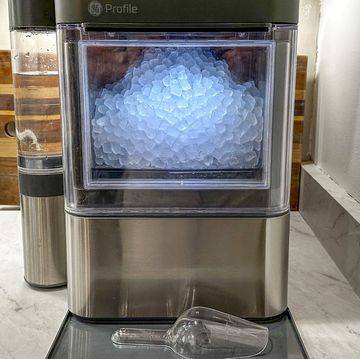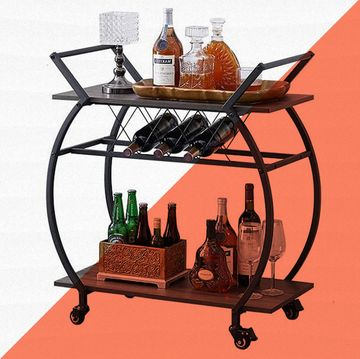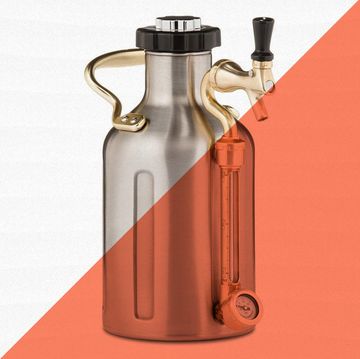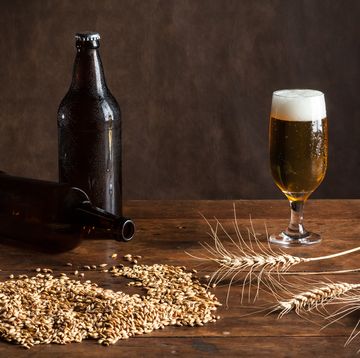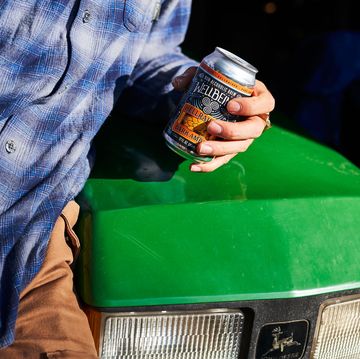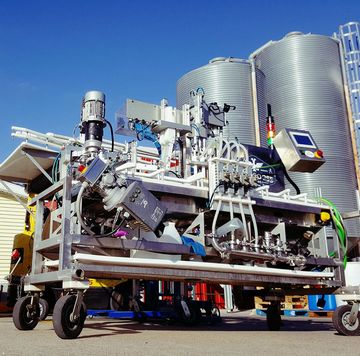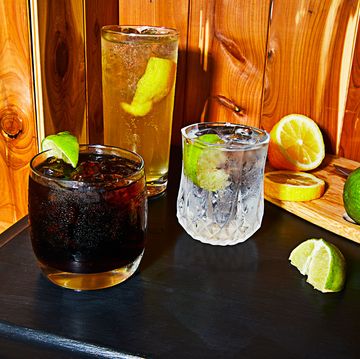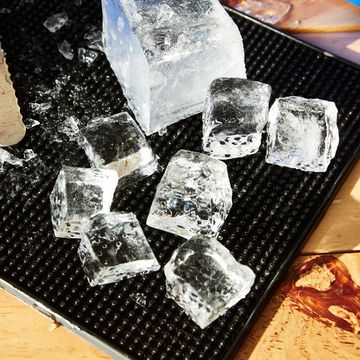There's nothing quite like a freshly poured beer from a draft system, but for most of us draft beer has been a pleasure that you only get at bars and restaurants. That's a shame, because kegged beer is a cheaper, fresher, better preserved product. To top it off, some craft breweries also offer beers in kegs that they don't sell in bottles or cans.
You can buy a ready-built kegerator, but with a price tag that usually exceeds $700, you're spending a lot of money to buy a fresher beer. Luckily, there's a better way to get a draft system in your home. For years the community of homebrewers have been modifying compact refrigerators and chest freezers and turning them into the at-home bar of their dreams. All it takes is about $400 in materials, a few hours of work, some basic DIY skills, and a disregard for product warranties. Here are our step-by-step plans for building the most basic draft system.
Step 1: Choose Your Refrigerator
To demonstrate our project, we chose to buy a new Frigidaire FRC445GM 4.4-cubic-foot refrigerator, but there are dozens of models of compact refrigerators that will work. Craigslist, Ebay, and open-box items at your local electronics retailer are all great ways to save money on your fridge. Here are key aspects of a convertible fridge:
* As far as capacity goes, most 4.4- to 5-foot models will work for one or two kegs that hold one-sixth of a barrel of beer. Be sure that the fridge you're buying will accomodate the kegs you want to use. This chart illustrates keg dimensions.
* Choose a model with no freezer compartment or a freezer compartment that's easily removed. If cooling lines are present in the freezer compartment, you cannot remove the freezer.
* Check the location of the cooling lines, especially in the top of the fridge. Read on for tips on locating cooling lines.
Step 2: Choose Your Kegerator Conversion Kit
There are a few online vendors that sell these kits, and you can expect them to run about $180 for a one-tap system to $290 for a two-tap system. Your kit should include a serving tower with one or two faucets, a 5-pound CO2 tank with a regulator to adjust serving pressure, gas lines, beer lines, and one or two disconnects, either homebrew or commercial Sanke, chosen according to which meets your needs. (Both are pictured here, the black-handled coupler is the commercial disconnect.) The only difference between a commercial kit and a homebrew kit is the disconnects; everything else is identical. The three metal rails at the top were not part of our kit. They're stainless-steel drawer handles that we'll use as rails for the lid of our kegerator.
Step 3: Disassemble the Fridge
Unscrew the door of the fridge and remove all loose shelving. You'll need lots of room inside for the keg(s) and C02 tank.
Step 4: Remove the Plastic Top Piece
Check for screws holding the plastic piece at the top of the fridge in place–you might find that it's just glued on. Pulling it off can prove difficult, so work a thin spatula under the lid and gently tap on the bottom of the plastic piece with a hammer, working your way around the fridge until you feel it starting to give. It takes a while to remove, but once you get it started the lid gradually peels off. We found that it was best to pry the lid from the back of the fridge forward.
Step 5: Find the Cooling Lines
Cooling lines typically run up and down the sides and sometimes across the top or bottom of a refrigerator to keep the contents cool. One cut into these lines and the fridge is dead. Pick out the spot you want to install your tower and gently dig through the insulation with a spatula. The lid will probably leave indentations in the insulation—use these as guides to keep the hole needed for the tap centered. Sure enough, we found two cooling lines nestled at the bottom of the fridge.
Step 6: Drill a Hole in the Fridge
Choosing your bit carefully, use a holesaw to drill in between the delicate cooling lines. Since we had so little room to work with we drilled twice and cut away at the plastic interior to create an oval hole. You want plenty of room to accommodate two liquid lines that will run through the opening in addition to a 1-inch-diameter cooling line that you'll be installing later.
Step 7: Prepare the Lid
The stainless-steel tower of the system is relatively heavy, so reinforce the plastic lid with some plywood. Use a pair of pliers to break off the ridges on the bottom of the lid and then sand them down. By removing the ridges you allow the plywood to mount flush to the plastic lid. Use the ridges to locate the center of the spot where you want to mount the tower, and drill a small pilot hole there.
Step 8: Make Room for the Plywood
Cut a ½-inch thick piece of plywood down to 9 ¼ x 6 ½ inches and trace its shape on the insulation surrounding the hole. Then cut out enough insulation to allow the plywood to mount flush to the top.
Step 9: Install the Plywood and Mark It for Drilling
Install your plywood reinforcement and temporarily remount the lid. Then use the pilot hole that you drilled in the lid as a guide to mark the spot where you want to drill out the plywood. You can see the mark we made in the center of the plywood.
Step 10: Drill the Lid and Plywood
Now that you have a pilot hole in the plastic lid and a marking for the plywood, attach a holesaw to the drill and make a 3-inch hole. Make sure you're confident that the hole is in the dead center of the lid and perfectly lined up with the plywood and fridge below. Remove the lid and the plywood when drilling so that you don't damage the cooling lines in the fridge.
Step 11: Install a PVC Conduit
Use a 2.5-inch-wide section of PVC piping to connect the bottom hole to the tower and insulate the conduit and the bottom side of plywood with moisture-resistant aluminum tape. Since the PVC sits on top of two cooling lines, make sure it is cut short enough that it won't bear the weight of the tower. Cut the conduit at a slight angle so that it matches up with the oblong hole in the fridge.
Step 12: Install the Tower and Rails on the Lid
The tower installs via four screws through the base. Drill pilot holes for each screw through the lid and through the plywood below and then install the screws. Pick up some stainless-steel cabinet drawer pulls to install on the top of the fridge as a decorative touch. It was tough to measure and achieve perfect placement—the back rail ended up about an eighth of an inch off center, but we still think it ended up looking pretty sharp, and it was well worth the effort.
Step 13: Relocate the Thermostat and Light
It's going to be a tight fit to get two Cornelius kegs into this fridge, so we'll need to relocate the thermostat and light, moving them a few inches back to make some room. If you're only going with a single tap this step is unnecessary.
Step 14: Construct the Tower Cooling System
Our home draft system is nearly complete, but we have one challenge left to overcome. The refrigerator will keep the beer in our kegs cold, but air in a refrigerator tends to stratify—that is, the cool air sinks and the hot air rises. As of now, the beer suspended in the lines of the tower will be far warmer than the air below. Without a way to cool the tower, the warm beer coming out of the faucet will instantly foam up. We repurposed the fan from an old computer that was gathering dust in the attic as the heart of our cooling system.
Step 15: Build a Fan Box
We could have gone to a local electronics store to purchase a plastic project box where we could install the fan, but an old Tupperware container works just as well for our purposes. The fan box will be hidden behind the kegs so don't worry too much about the aesthetics. Drill three holes into the container: one for the fan, one for the tube which will direct air to the tower and a tiny one for the power cable.
Step 16: Power the Fan
We had an old Atari power cord lying around which we connected to the fan as a power source. It's simple to cut off the end of the plug, strip the power cord's wires and twist them into fan's wires—black to black, white to red. Crimps make the connection permanent once the fan box is ready for installation inside the fridge. Cellphone chargers also make for an easy-to-get power supply.
Step 17: Install the Fan Box and Reattach the Lid
Run a 1-inch wide length of vinyl hose up into the tower and down to the cooling box, which rests on the compressor hump of the fridge (with the power line slipped through the drainage hole in the back of the fridge). When the cooling box gets plugged in, the fan sucks the cold air out of the bottom of the fridge and forces it up through the vinyl tube and into the tower to keep the beer in the lines cool. With the cooling system in place, reattach the lid, filling in the area around the PVC pipe with Great Stuff window and door foam. The brand name isn't important, but be careful not to select an insulating foam that expands too much or you risk damaging the fridge. Use a silicone caulk to reglue the lid back on the top of the fridge.
Step 18: Reattach the Door
Once the door is on the fridge, all you have to do is hook up fresh kegs and a full CO2 tank and enjoy your beer. If your CO2 tank came empty you can usually get it filled at a local welding company, paintball store or fire extinguisher company for about $15 to $20. As our system is currently configured it can accommodate two Cornelius kegs or a one-sixth-barrel commercial keg (just over 5 gallons of beer, or 55 bottles). Click through for tips on selecting an ideal fridge and for ways to simplify your build.
Step 19: Expert Tip
Tim Myers modified the same fridge that we did, but he avoided the hassle of cutting open the top of the fridge and the risk of hitting the cooling lines by installing his taps directly into doors of the fridge.
Step 20: Expert Tip
When Derek O'Halloran modified his Sanyo 4912 refrigerator he was wasn't sure where the cooling lines were located. To figure it out he removed the plastic top of the fridge to reveal a metal top. He then mixed cornstarch and vodka into a slurry and applied it liberally across the top of the fridge. When he plugged the fridge in, he noted that the slurry evaporated the fastest in a single line across the back third of the fridge – this was the location of the cooling line. In the picture you can see how this line gradually expanded into the bright spot at center. He knew he was free to drill the hole for his tower a few inches in front of this line.


